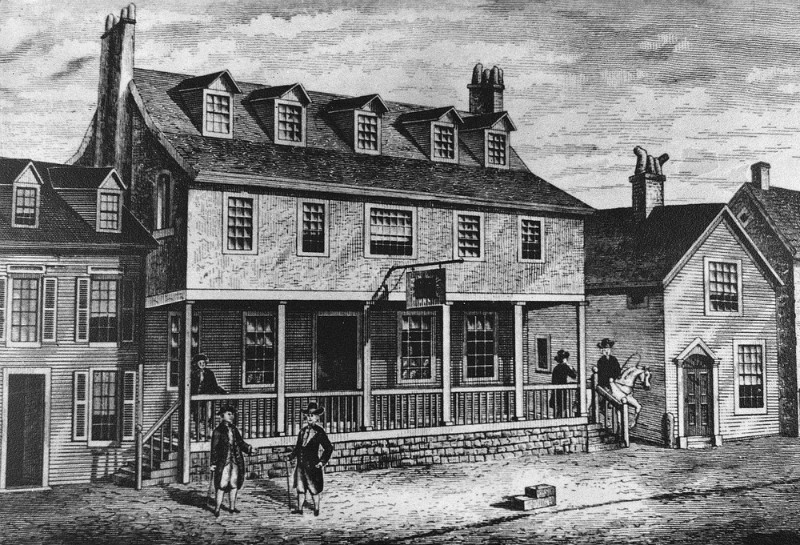The Colonial Tavern, Crucible of the American Revolution

Alcohol, bars, and innovation have a storied relationship. Whether it’s the infamous Pet Rock, which Gary Dahl conceived while drinking with friends, or the idea behind A Few Good Men, which Aaron Sorkin thought up while bartending at the Palace Theater, alcohol has infused some of the most famous and infamous aspects of American life. However, to truly comprehend the roles alcohol, and more specifically bars, have played in America’s history, one must harken back to the Colonial era when taverns, as they were then called, helped shape American history.
While alcohol was a prominent fixture in Colonial life, oftentimes the location where one consumed said alcohol was equally as relevant. Public houses, and more specifically taverns, played an especially important role — they weren’t simply places to drink. Rather, they served as a venue to meet like-minded individuals, and functioned as clearinghouses and test beds of revolutionary ideas. As the colonies took shape, taverns became central locations for several aspects of colonial life. According to the U.S. Postal Service, early colonists adopted a practice used frequently in Europe and established taverns as a place to collect and distribute mail sent from overseas. In addition, according to the Gettysburg Historical Journal, taverns became a “means of direction for travelers, as well as settings where they could eat, drink, be entertained, and spend the night.” Taverns were also “utilized as meeting places for assemblies and courts” and became a central location for discussion and debate. In taverns across the colonies, literate patriots drank and read the news of the day aloud to their fellow revelers, thereby stoking revolutionary fervor. The network of taverns not only provided travelers with a place to rest and enjoy a beverage, but also a place to bring news from other colonies, and promulgate ideas from the likes of Thomas Paine, James Chalmers, and Thomas Jefferson.
However, arguably the taverns’ most important role in society (and American history) is the role they played in the beginning of the Revolutionary War. As anger spread throughout the colonies, many took to the tavern to discuss, argue, and debate what needed to be done. One location in particular, Boston’s Green Dragon Tavern (or as Daniel Webster put it “the Headquarters of the Revolution”) played host to the infamous “Sons Of Liberty” who, presumably after a couple of pints of spruce beer or molasses-infused porters, plotted the “Boston Tea Party.” It’s not hard to imagine why a couple of ales could have played a role in nudging along the idea of dressing like a Native American and dumping some of the East India Company’s finest tea into Boston Harbor.
The implications of the tavern go beyond just the spread of ideas. Two of our nation’s most significant institutions, the Freemasons and the United States Marine Corps, trace their origin back to the same colonial taphouse. According to historical records, the Tun Tavern in Philadelphia hosted the first meetings of St. John’s Lodge No. 1 (the first American lodge of the Grand Lodge of the Masonic Temple). On November 10th, 1775, the tavern also became the birthplace of the United States Marine Corps. Historically, the tavern was a popular destination for military recruitment, with Ben Franklin recruiting for the Pennsylvania Militia there in 1756. Eventually, the tavern would play host to Washington, Jefferson, and the First Continental Congress, who would task the tavern’s owner, Samuel Nicholas, “to raise the first two battalions of Marines” out of the tavern’s guests (although some speculate this occurred at another tavern owned by the Nicholas family, the “Conestoga Waggon [sic]”). The USMC still commemorates November 10th annually, with Marines everywhere raising a glass in honor of the Tun Tavern.
After the war, the concept of the tavern persisted, but waves of immigration, changes in drinking habits, and new advances in communication and publishing obviated the role of the tavern as a central location in society. However, if you wish to recreate that tavern spirit, many are preserved as historic locations, and replicas have cropped up across the former colonies. Furthermore, thanks to some enterprising modern breweries seeking to recreate that revolutionary spirit, we might finally have the opportunity to try some of the historic ales that once graced the taps of the Green Dragon and other colonial taverns. Yards Brewing Company, a Philadelphia-based brewery, is attempting to recreate a few of the recipes our forefathers left behind. In their “Ales of the Revolution” series, Yards has set out to recreate Thomas Jefferson’s Tavern Ale, Poor Richard’s Tavern Spruce, and General Washington’s Tavern Porter. Ranging in alcohol content from five-to-eight percent ABV, these recipes attempt to maintain authenticity by using similar ingredients and historic recipes compiled straight from the records of Jefferson, Franklin, and Washington. Whether or not they’re actually accurate is anyone’s guess, thanks to inconsistencies in labeling and recipes on the part of our forebears.
While the authenticity of these beers is up for debate, the role of the tavern in Colonial America is not. The next time you’re in a bar with friends, talking about what you may think is nothing in particular, remember the impact and significance that alcohol and taverns have had on American society — maybe you too can come up with something revolutionary.
Salvatore Colleluori is a political writer by day and a homebrewer and beer enthusiast by night. He holds a degree in Political Science from the George Washington University and enjoys reading about alcohol, history, and foreign relations. He is also an avid music lover, specifically jazz and the Grateful Dead.
Image: Philadelphia’s Tun Tavern, date unknown

